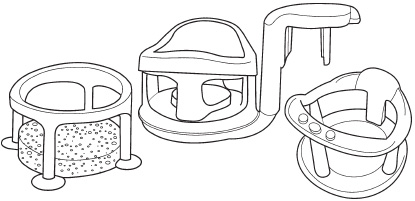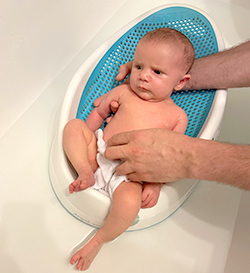Bathing your baby
Most children love bath time. It’s a special moment with mommy or daddy. It’s also enjoyable and relaxing. These private moments will help you get to know your baby. With time you’ll become more and more sure of yourself.
The ideal moment
You can bathe your baby at any time of day. There’s no ideal time. It’s really a matter of when your baby appears willing. Bath time will be less pleasant if your baby is hungry or tired. You’ll get to know when the ideal moment is for your baby.
Frequency
There’s no need to bathe your baby every day.
However, some parts of the body do need to be cleaned daily. Use a damp washcloth to wash your baby’s face and neck. Add a little soap to clean the hands, genitals, and bottom.
Getting ready
Gather together all the items you need before undressing your baby. Do not leave her side during bath time. Being prepared is essential for making sure your baby’s safe and comfortable.
Here are a few items you might need:
- Washcloth and towel
- Mild, unscented soap and baby shampoo
- Clean clothes
- One or two diapers
- One or two cotton swabs for cleaning her belly button
- Small nail scissors or a nail clipper and nail file
- Zinc oxide ointment for her bottom
- Unscented moisturizing cream or lotion (for places where her skin is dry)
- Brush or comb
Adjust the room temperature if you can, ideally to 22 to 24°C.
Soap: mild and unscented
Children, especially newborns, have sensitive skin. Soap removes the natural protection of your baby’s skin and can irritate it. So it’s best to use mild, unscented soaps.
Use a small amount of soap and apply it only to your baby’s hands, bottom, and genitals. The rest of her body doesn’t need soap.
Avoid antibacterial soaps because they contain alcohol. Scented products such as bubble bath and bath oils are unnecessary and can cause irritation.
Bathing
![]() Health Canada advises against using bath seats to ensure the safety of babies in a bath tub. They give adults a false sense of security, which can lead to drowning.
Health Canada advises against using bath seats to ensure the safety of babies in a bath tub. They give adults a false sense of security, which can lead to drowning.

Bath seats for infants. Illustration: Health Canada
You can wash your baby in an ordinary bathtub, a baby bath, or the bathroom or kitchen sink if it’s clean. You may also choose to take her in the bath with you. If so, put a nonskid bath mat in the bottom of the bath tub to reduce the risk of slipping.
A few centimetres of water in the tub are enough to wash your baby. For older children, the water level in the tub should not be higher than their belly button when they’re seated.
Run the hot and cold water at the same time. The water should be warm, i.e., at your body temperature (34 to 37°C). To avoid burning your baby, always check the water temperature with your elbow or wrist.
Undress your baby only when everything’s ready so she doesn’t get cold. Put her slowly in the water, starting with her feet. Then gently immerse the rest of her body. Hold her head, supporting her neck with your forearm and sliding your hand under her armpit (see picture below).
How to bathe baby

![]() When you bathe your newborn, hold her head, supporting her neck with your forearm and sliding your hand under her armpit.
When you bathe your newborn, hold her head, supporting her neck with your forearm and sliding your hand under her armpit.
Photo: Karelle TB
![]() Never leave your baby alone in the bath, for whatever reason, even for just a second. A baby can drown in as little as 2.5 cm (1 in.) of water. If the telephone or doorbell rings, take your baby with you. You can also simply choose not to answer.
Never leave your baby alone in the bath, for whatever reason, even for just a second. A baby can drown in as little as 2.5 cm (1 in.) of water. If the telephone or doorbell rings, take your baby with you. You can also simply choose not to answer.
Whether you wash your baby with a washcloth or in a tub, here are a few practical tips.
- Clean her face first with a wet washcloth:
- Clean her eyes starting from the inside corner (near the nose) toward the outside corner. Use a different corner of the washcloth for each eye.
- With another corner of the moistened washcloth, gently clean outside and behind her ears. Avoid going too far inside the ear. Don’t use cotton swabs (Q-Tips®), because they can injure the eardrum and push earwax even farther into the ear.
- Then carefully wash all the folds of the body:
- Don’t forget the folds of the neck, armpits, thighs, and bottom. Rinse well.
- Wash the genitals and bottom last:
- For baby girls, gently wash the vulva by separating the outer lips. Wipe from front to back. That way you avoid traces of fecal matter from coming in contact with the entrance to the vagina and urethra. Rinse well.
- For baby boys, wash the penis and scrotum. Rinse well. The foreskin is not detached from the tip of the penis at birth. Avoid doing anything that will detach it. It’s not necessary to dilate it to clean it.
- After the bath, dry your baby well without rubbing. Dry all the folds well to prevent redness and dampness. Remember also to dry around the umbilical cord. It’s not a good idea to use powder because it can cause breathing problems.
If the baby is still covered in vernix caseosa you don’t need to rub it off. It will be reabsorbed within a few days.
Hair
You don’t need to wash your baby’s hair every day. Once or twice a week is enough. Avoid rubbing when using shampoo, and be gentle over the fontanelle (soft spot). Then rinse well with clean water and gently pat it dry.
Vernix caseosa: A whitish substance coating the skin of a newborn baby.


